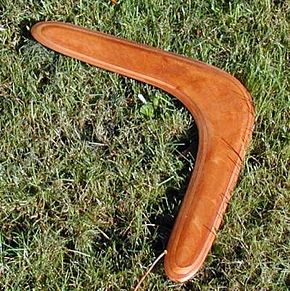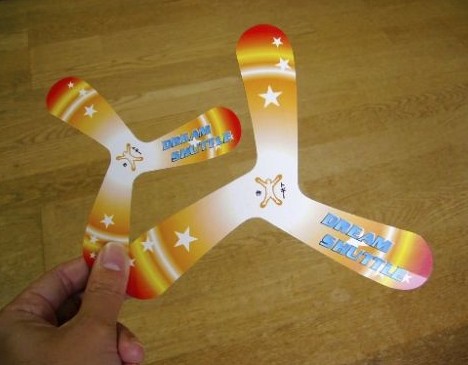Boomerang Definition :
A boomerang is a thrown tool, typically constructed as a flat aerofoil, that is designed to spin about an axis perpendicular to the direction of its flight.
A returning boomerang is designed to circle back to the thrower.
Boomerangs have been historically used for hunting, as well as sport, and entertainment. They are commonly thought of as an Australian icon.
A boomerang is usually thought of as a wooden device cut from a tree trunk, although historically boomerang-like devices have also been made from bones. Modern boomerangs used for sport are often made from thin aircraft plywood, plastics such as ABS, polypropylene, phenolic paper, or even high-tech materials such as carbon fibre-reinforced plastics. Boomerangs come in many shapes and sizes depending on their geographic or tribal origins and intended function.
An important distinction should be made between returning boomerangs and non-returning boomerangs. Returning boomerangs fly and are examples of the earliest heavier-than-air man-made flight. A returning boomerang has two or more airfoil wings arranged so that the spinning creates unbalanced aerodynamic forces that curve its path so that it travels in an elliptical path and returns to its point of origin when thrown correctly. While a throwing stick can also be shaped overall like a returning boomerang, it is designed to travel as straight as possible so that it can be aimed and thrown with great force to bring down game. Its surfaces therefore are symmetrical and not uneven like the aerofoils which give the returning boomerang its characteristic curved flight.




















A boomerang is a thrown tool, typically constructed as a flat aerofoil, that is designed to spin about an axis perpendicular to the direction of its flight.
A returning boomerang is designed to circle back to the thrower.
Boomerangs have been historically used for hunting, as well as sport, and entertainment. They are commonly thought of as an Australian icon.
A boomerang is usually thought of as a wooden device cut from a tree trunk, although historically boomerang-like devices have also been made from bones. Modern boomerangs used for sport are often made from thin aircraft plywood, plastics such as ABS, polypropylene, phenolic paper, or even high-tech materials such as carbon fibre-reinforced plastics. Boomerangs come in many shapes and sizes depending on their geographic or tribal origins and intended function.
An important distinction should be made between returning boomerangs and non-returning boomerangs. Returning boomerangs fly and are examples of the earliest heavier-than-air man-made flight. A returning boomerang has two or more airfoil wings arranged so that the spinning creates unbalanced aerodynamic forces that curve its path so that it travels in an elliptical path and returns to its point of origin when thrown correctly. While a throwing stick can also be shaped overall like a returning boomerang, it is designed to travel as straight as possible so that it can be aimed and thrown with great force to bring down game. Its surfaces therefore are symmetrical and not uneven like the aerofoils which give the returning boomerang its characteristic curved flight.
Boomerang

Boomerang

Boomerang

Boomerang

Boomerang

Boomerang

Boomerang

Boomerang

Boomerang

Boomerang

Boomerang

Boomerang

Boomerang

Boomerang

Boomerang
Boomerang

Boomerang

Boomerang

Boomerang

Boomerang

No comments:
Post a Comment